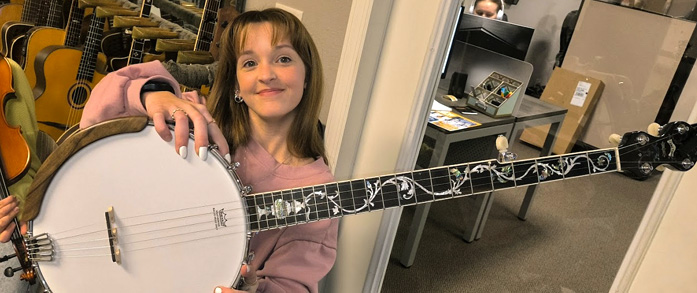Bayla Davis with her new custom Gold Tone open back banjo
Gold Tone Music Group has announced their newest endorser, and perhaps their youngest, in the person of Bayla Davis, a 17-year-old old time player from western North Carolina. In just a few years time, this talented young lady has turned heads all across the music world for her skillful playing, and her full-on embrace of traditional mountain music.
Last spring she was chosen to be featured on From The Top, a television show and podcast that highlights exceptionally talented teen musicians. For years the show focused on classical artists, but has only recently begun to showcase traditional music players like Davis and Wyatt Ellis.
Bayla says that she is delighted with her new banjo, one that was custom built for her unique stylistic preferences as a clawhammer picker who also plays bluegrass, and by having one made just for her.
“I am really excited to be endorsed by a banjo company! I actually thought only really famous instrumentalists could be endorsed, but I was really excited when some of my friends recently got endorsed, and then I got asked a couple weeks following! It really seems like the music world is beginning to take the younger generation seriously and professionally, and I am really thankful.
I’ve only ever played Gold Tone banjos, but the ones I currently have are only banjos that I have won or never picked out personally. I was invited to Titusville, Florida during my Christmas break from school to check out a custom banjo they had begun to work on for me, and to show me around the factory. I visited Mr. Justin and Mr. Wayne, who I’ve known for years at various festivals, but it was amazing to see them in their working environment, and to meet the luthiers
When I was asked what type of banjo I would be interested in, they were very surprised that I wanted something exactly like a resonator banjo (I play clawhammer, so that isn’t very common); however, I wanted an open back to promote my style and the culture of old time music.
They put together an open back Tubaphone banjo, with three rings, and very low action for a loud and bright sound. They put on an Ome armrest, and they used a gorgeous Gold Tone neck with all the frets and no scoop (usually something only resonators have). I played it for the first time with my siblings in Mr. Justin’s office, and the only thing that was changed was the string gauge sizes: I like to have different weird sizes for the strings specifically so nothing buzzes. I’ve found that clawhammer is a rougher style that can hit the strings in a certain way that promotes annoying pick noise and a ring – and the luthier was able to adjust them in minutes.
I have officially named my new baby banjo “Frankenstein,” because it is a banjo made up of many other parts of different banjos. I feel like average open back banjos are muffled and softer, but because I play more bluegrass and contemporary on clawhammer than I do old time, I wanted to be able to be heard just as loud and clear as other players, but with my own style.”
Well done Gold Tone!
Young Ms. Davis is currently absorbed in applying to music colleges, looking for the best fit for her particular interests.
Hey music schools… time to reach out to this talented artist!
